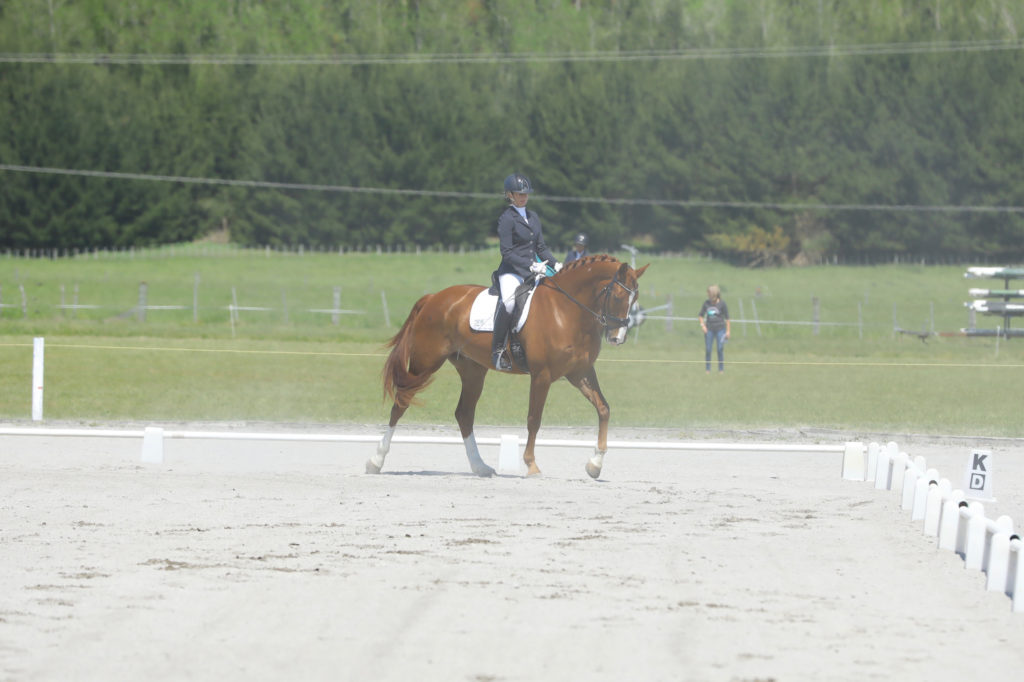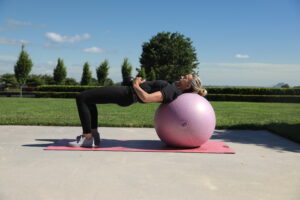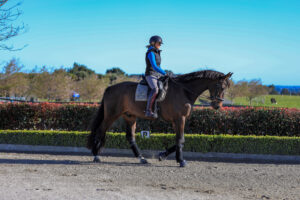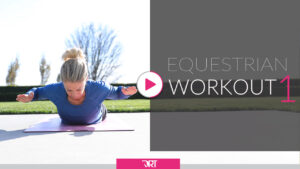Improving Your Dressage Basics
Keep improving your dressage basics and gain an understanding of what the judges are looking for at each level of your dressage test.
I have certainly ridden my share of dressage tests, and in the last couple of seasons since being back competing with my young dressage horse, I have learnt a lot about the dressage basics and gone back to building this foundation first. So today, I want to share why improving your dressage basics is important and how you can do just that.
You see, for me to improve, I have taken the time to get a solid understanding of the sport of dressage today and to be a student. This was to understand what it is that we are actually trying to do when training horses to do the dressage movements and improving our horse’s way of going.
I wanted to share with you what I have learnt and how I have improved our marks as the season continues.
Improving Your Dressage Basics
When you start out on your dressage journey, the first thing you focus on is remembering your test. I definitely have had my fair share of course errors, and most of them were simply nerves related. In some cases, my only goal of the competition was to get on, ride and come home again. That was a win.
However, as the seasons progressed and my relationship built with my young horse, remembering the test got easier, and I was then able to start to fine-tune things a little bit more and think about riding a good test (not just completing it and staying in the arena and crossing my fingers he would load onto float the way home again).
Before you understand how to get a better score, it makes sense to start with understanding how dressage scores work and what the judges are looking for.
Understanding how dressage scores work and why the dressage basics matter
What is a good dressage score? On average overall scores of 70% or over for a dressage test are considered very good, scores of 60-70% are considered good, and if a horse and rider are consistently scoring 65% or over at a level of dressage competition, this indicates they may be ready to move onto the next level.
How do dressage scores work? The higher the percentage, the higher the score in dressage. However, in eventing dressage, the score is calculated by dividing the points achieved by the total possible points, multiplying by 100 (rounded to 2 decimal points) and subtracting from 100. Thus, a lower score is better than a higher score.
Each movement within a dressage test is scored out of 10, with a 10 being excellent. There are also movements within a test with coefficients meaning the score is doubled. So before you do your test, understanding which movements count more than others is worthwhile. Movements like free walking often show how relaxed the horse is and these are often the double marks.
Understanding what the dressage judges are looking for
Another part of improving your dressage basics is understanding the purpose. Within each level of dressage, there is a purpose from level one through to Grand Prix. It is for this purpose that the judges base their impressions. Then each movement has a directive of what the judges are looking for with that specific movement.
See here in the Dressage New Zealand Official Test book 2013; beside each movement, there is a directive comment. Understanding these will help you with your test riding and how you ride each movement.
So once you have mastered the art of memorising your test, look into the finer details of each movement and work on what the judges are actually looking for from horse and rider and basing their marks off.
For example, movement 1 of level 1, entering your dressage arena, isn’t just about doing a straight line; the judges are looking for “the quality of the trot. The straightness on the centreline. The bend and balance of the turn.” The judges are looking at the horse’s body and how it moves, not just the movement itself.
The purpose of dressage and improving at each level
The other part of each level is a purpose and, again, often overlooked when your goal is to remember your test. It is, however, a very useful paragraph to read and understand what the goal of your level is and what the judges are looking for and what to aim for when looking at fine-tuning your test and horse’s way of going. These outlines are usually sitting at the front of your test book. Or visit the websites of USDF (united states dressage federation), FEI, British Dressage or NZ Equestrian for Dressage NZ information.
Purpose of the Level 1 dressage tests
“to confirm the horse has developed and maintains a rounded natural outline without restriction, moves freely forward without collection but with active hindquarters whilst maintaining a steady rhythm and contact with the bit without tension or resistance.”
Purpose of Level 2 dressage tests
“to confirm that the horse has developed an established rounded outline without restriction, moves freely forward without collection but with active hindquarter and achieved a degree of balance, straightness and throughness. The horse should be in steady light contact with the bit without tension or resistance.”
Purpose of Level 3 dressage tests
“to confirm that the horse, having demonstrated that it has achieved through correct training the suppleness and muscular development so that it accepts more weight on the hindquarters (collection), shows a higher more rounded outline and the uphill tendency required at the medium gaits and is reliably on the bit and therefore able to show sufficient engagement to carry out the movements with necessary amount of collection required.”
Purpose of Level 4 dressage tests
“to confirm the hrose has now developed the increased rhythm, suppleness and impulsion to collect and extend its paces, maintain a light, uphill outline enabling it to show a dress of cadenced paces and perform direct transitions smoothly and with precision”
Purpose of Level 5 dressage tests
“to confirm the horse has now developed and can maintain the increased rhythm, suppleness and impulsion to collect and extend its paces, maintains a light, uphill outline thus enabling it to show a greater degree of quality and cadence in its paces enabling it to perform with greater engagement and collection.”
Purpose of Level 6 & 7 dressage tests
“the horse now has the increased rhythm, suppleness, straightness, throughness and impulsion to collect and extend its paces, maintain a light, uphill outline enabling it to maintain cadenced paces necessary to perform the more difficult movements of FEI tests.”
So now, when you look at each movement directive, like movement 1 of level 1, also think about the purpose of level one. The centre line movement must show the horse moving freely forward with an active hind leg and no resistance. The horse needs to be in front of your leg, and there is no lack of balance with all three paces of the walk, trot and canter and a nice rhythm and balance.
Improving the accuracy of your dressage test by improving your dressage basics
Next comes mastering the art of accurate tests through practice and understanding the shapes and where they all sit within a dressage arena. One thing I have found incredibly useful is the diagrams as part of the Dressage test book. Look at where each movement starts, finishes, the shape of the movement, and the bend.
See here an example from the Dressage New Zealand 2013 Official test book, but you can also find these all over the internet if you are having trouble.
Assuming a circle goes from marker to marker is one of the first mistakes I always used to make. So before I do any new test, I make sure I understand where it should be and the exact size and placement in the arena.
You can lose so many marks by not riding accurately, and this is an art to practice and something you can easily fine-tune if you put the focus into it. Plus, you can do much of this off your horse by studying each movement and its position in the arena.
Don’t underestimate the power of accurate lines in a correct rhythm and balance with the right bend (easier said than done). This will help you score those higher marks on your dressage test. So practising these when you are schooling and paying attention to the details at home does pay dividends.
I have found that the more I pay attention to the finer details, the more my tests have improved. These finer details are all things you can spend time doing off your horse and on. It is essentially homework and studing your test movements by looking for those hidden gems of purpose and directive that are provided with your tests.
How do I get better at dressage?
As I mentioned above, using the pyramid of training and really getting an understanding of how it works and what judges are looking for is the best place to start. Learn how to improve your dressage basics by understanding what judges seek.
Then in terms of the actual training and development of your horse, we have developed a training system built upon the scales of training aka pyramid of training to help you develop your horse correctly and systematically at home. Discover the exercises, weekly structure and system you can apply today to your training with our sister site, dressage horse training.
Take away the guesswork and follow this proven system from young green broke horses through to competitive Grand Prix.
Learn how to do dressage basics, teach your horse the movements in the first place, and then discover how to develop them into confident, happy athletes correctly. You can systematically approach your training confidently when you learn the dressage basics and the fundamental elements the training scale built upon.
Top tips on how to keep improving your dressage basics
Once you understand your dressage basics and how judges use the training scale as a foundation for giving you marks, you can then start to understand why the scales of training matter and the mastering all the basics of dressage are key. So if you are looking for some quick ways to get those extra marks in your dressage test, or to improve your harmony and relationship with your horse training at home, here are some top tips to finish with.
Learn your dressage test well
This includes the purpose of the level, the directives of each movement and where the coefficients are.
Improve your basic accuracy
Be accurate, understand where the movement falls within the arena layout. Make sure 10m circle are 10m and your 20 circles hit the sides of the arena where they should.
Never stop learning
Understand the basics of each level, study the tests and be a student hunting out ways to grow. Read your test results and feedback the judges are given you.
Enjoy yourself
Remember to smile, enjoy yourself and stay kind to your horse. Even if you’re full of nerves and smile can go a long way.
Practice, Practice + Practice
This goes without saying but practice how you wish to ride the test off the horse as well as on. Video yourself doing the test, watch yourself through the judges eye and see if you are meeting the purpose and directives. Score yourself and work on improving each score.
I hope you have found this useful, I believe there is so much we can learn along the way and one of the biggest mistakes is stopping that learning and growing process. So even if you have been competing for years, you may have hit a roadblock. Have a real read of your test book, video yourself, get guidance and start to assemble the puzzle pieces that are missing.
The more you do this, the more you will find those little hidden marks that can make all the difference in your final score.
Want to learn more about dressage and the scale of training, check out these article
What is the Dressage Pyramid of Training
What Is Dressage And How Do You Get Started
Want more FREE articles to help you with your dressage rider training? Try these out?
What is dressage and how do I get started
Dressage Rider Exercises For Improved Fitness
Dressage Rider Leg Strength & 6 Exercises To Help You Improve
Dressage Rider Exercises For Improved Fitness
Upper Body Exercises For Dressage Riders
Horse training exercises using the pyramid of training
We have created a simple training system with our sister site Dressage Horse Training that is built upon the training scale also known as pyramid of training
Learn how to structure your weekly training and see it applied to various horses from young green broke to Grand Prix.
Get the exercises and guidance from a proven training system professional riders use. Learn how to overcome training errors, teach your horse new movements and develop yourself into a confident dressage rider.
The secret to success is following a simple and proven system. So whether you are figuring out how to get started with dressage or a more advanced competitive rider, we cover everything you need to help you with your training at home. No matter where in the world you are based.
Learn how to master the art of dressage horse training, improve your dressage scores and make dressage easier to master.
To get started, check out these articles
How to get started with dressage
How to structure your dressage training for your horse
What is a dressage competition
Dressage Rider Training Program
Join other participants on our 12-week 'step-by-step' online rider
training program. Improve the 5 components of your riding.
Only available 3x per year.
see full details & register your interest










